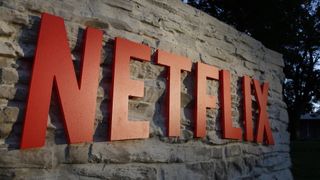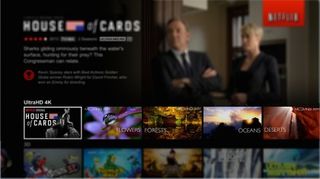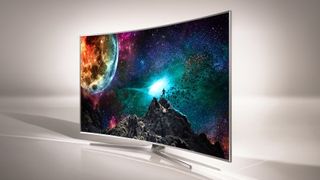What's next for Netflix's streaming tech?
The heavenly trinity of Ultra HD, HDR and HFR...

To paraphrase the Great Book, Netflix is big. Really big.
From its humble beginnings mailing DVDs out to folk tired of trekking down to Blockbuster (who?) to its ever-growing video streaming service, Netflix has become a vast global player in the media game.
This year will see the service rolling out in Spain, Italy, Portugal and Japan, with plans to go global next year.
Not only is Netflix serving us a steady diet of content to binge on, but is also commissioning its own successful shows and now, with the Crouching Tiger, Hidden Dragon sequel, it's going after movies too.
Content is obviously a huge part of the picture; it's that which draws in the crowds and, by seeking to offer a varied range of video for our eyeballs to devour, it's also what's going to keep them paying that subscription fee.
In an increasingly fragmented video-on-demand market, and new services popping up seemingly every day, holding on to subscribers is going to be vital and the content has to be key to that.

But content is only a part of it. The technological advances Netflix is chasing are also big news for the company and something that will keep it at the forefront of the streaming game.
Get daily insight, inspiration and deals in your inbox
Get the hottest deals available in your inbox plus news, reviews, opinion, analysis and more from the TechRadar team.
Ultra HD streaming is the current buzzword of the video industry, flinging super sharp images down the net tubes to the burgeoning number of 4K UHD TVs sitting in people's homes.
Netflix has a growing catalogue of UHD goodness, accessible via the TV app on 4K UHD smart TVs. At the moment there aren't huge amounts of 4K shows around, but it is growing and, as 4K UHD TV sales grow, demand will steadily grow.
Better pixels
Following that will be the addition of high dynamic range (HDR) content later this year.
"We're also working on the next step," Netflix's Noesjka van der Helm explained to us this week. "With 4K screens we have the resolution we need. Now it is about getting better pixels, not more pixels, to give viewers a much more exciting TV viewing experience. Put simply, HDR is a way to bring greater definition and variation of colour to images."
HDR is actually being seen as a bigger step up in image quality than the move to the extra pixel count of Ultra HD.

"HDR ensures you're seeing extremely accurate colours that have a higher range," says van der Helm. "So instead of a ray of sunlight appearing washed out and white, you're able to notice the orange and yellow hues instead. It gives a much more exciting viewer experience with more colours, brighter highlights, better contrast and shadow detail."
Currently though Samsung's JS9500 and JS9000 SUHD TVs are the only ones we've seen to be capable of displaying HDR visuals. The others though are promising firmware updates for a lot of their flagship models, such as Sony's KD-75X9405C, later in the year.
So there is content ready for HDR; shows just waiting for the hardware to become prevalent enough to make it worth turning that tap and opening the stream.

And it's not just going to be a question of newly commissioned content being the only shows to turn up in all their HDR finery.
"Where it makes sense from a production perspective we will produce in Ultra HD 4K or HDR." says van der Helm. "We have a growing catalog of titles in UHD 4K, including Marco Polo, Sense8, House of Cards, Marvel's Daredevil, Bloodline, Better Call Saul, What Happened, Miss Simone? More than half of the new content coming onto Netflix will be 4K. Some of our Netflix originals are made with HDR in mind. We plan to be amongst the first to deliver HDR."
Netflix though isn't the first of the streamers to bring us HDR content though. Amazon Prime Instant Video has already been able to supply its own Mozart in the Jungle show and the Red Oaks pilot episode in HDR.
It's limited to US customers of Amazon Prime and then only those with a compatible Samsung SUHD TV, but it has at least proven its own capabilities of providing streamed HDR content.
"At Netflix we are uniquely positioned to deliver this experience to consumers," says van der Helm. "We work together with people across the chain, from shooting, editing, mastering, grading and colouring to integrate the best possible standards throughout."
With more movies being filmed with HDR in mind too, such as the latest Pixar movie, Inside Out, filmed in Dolby Vision, its future is not going to be just limited to TV shows either.
High dynamic range then is likely to be next battleground in image quality.
Where next?
Where does Netflix go from here then? It's not sitting on its laurels, waiting for the next big thing to reveal itself. No, it's pushing on with its own technological agenda.
"The next step will be putting more and more information in the pixels, so the experience will be better and better" explains van der Helm. "But also a higher frame rate so the experience becomes even better."
As the codecs for UHD streaming improves we'll see those streams improve in quality, which will be important when Ultra HD Blu-ray arrives later this year. The physical UHD Blu-ray media will likely be able to contain more image information than a UHD stream running on the HEVC codec currently being used.

The addition of high frame rate (HFR) content though is arguably more exciting. We've been stuck with the 24 frames per second movie standard since the days of passing celluloid in front of a candlelight.
As a frame rate junky I'm a big fan of HFR - it made The Hobbit the least cranially traumatic 3D experience I've had - and for certain shows the extra visual fidelity a higher frame rate will add should be a huge benefit.
I'm personally holding out for HFR to be used in live sports, but with Netflix championing the cause for TV and movie content that can only help.
"Those will be amongst our next steps," concluded Noesjka van der Helm. "We're always looking ahead to see what will be next to improve the viewer experience of our members."
